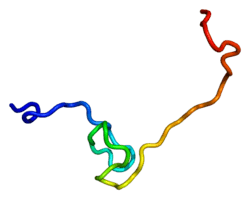MDM4
Protein Mdm4 is a protein that in humans is encoded by the MDM4 gene.[1][2]
Function
The human MDM4 gene, which plays a role in apoptosis, encodes a 490-amino acid protein containing a RING finger domain and a putative nuclear localization signal. The MDM4 putative nuclear localization signal, which all Mdm proteins contain, is located in the C-terminal region of the protein. The mRNA is expressed at a high level in thymus and at lower levels in all other tissues tested. MDM4 protein produced by in vitro translation interacts with p53 via a binding domain located in the N-terminal region of the MDM4 protein. MDM4 shows significant structural similarity to p53-binding protein MDM2[2]
Interactions
MDM4 has been shown to interact with E2F1,[3] Mdm2[4][5][6][7] and P53.[1][6]
References
- 1 2 Shvarts A, Bazuine M, Dekker P, Ramos YF, Steegenga WT, Merckx G, van Ham RC, van der Houven van Oordt W, van der Eb AJ, Jochemsen AG (Sep 1997). "Isolation and identification of the human homolog of a new p53-binding protein, Mdmx". Genomics 43 (1): 34–42. doi:10.1006/geno.1997.4775. PMID 9226370.
- 1 2 "Entrez Gene: MDM4 Mdm4, transformed 3T3 cell double minute 4, p53 binding protein (mouse)".
- ↑ Strachan GD, Jordan-Sciutto KL, Rallapalli R, Tuan RS, Hall DJ (Feb 2003). "The E2F-1 transcription factor is negatively regulated by its interaction with the MDMX protein". J. Cell. Biochem. 88 (3): 557–68. doi:10.1002/jcb.10318. PMID 12532331.
- ↑ Kadakia M, Brown TL, McGorry MM, Berberich SJ (Dec 2002). "MdmX inhibits Smad transactivation". Oncogene 21 (57): 8776–85. doi:10.1038/sj.onc.1205993. PMID 12483531.
- ↑ Tanimura S, Ohtsuka S, Mitsui K, Shirouzu K, Yoshimura A, Ohtsubo M (Mar 1999). "MDM2 interacts with MDMX through their RING finger domains". FEBS Lett. 447 (1): 5–9. doi:10.1016/S0014-5793(99)00254-9. PMID 10218570.
- 1 2 Badciong JC, Haas AL (Dec 2002). "MdmX is a RING finger ubiquitin ligase capable of synergistically enhancing Mdm2 ubiquitination". J. Biol. Chem. 277 (51): 49668–75. doi:10.1074/jbc.M208593200. PMID 12393902.
- ↑ Linke K, Mace PD, Smith CA, Vaux DL, Silke J, Day CL (May 2008). "Structure of the MDM2/MDMX RING domain heterodimer reveals dimerization is required for their ubiquitylation in trans". Cell Death Differ. 15 (5): 841–8. doi:10.1038/sj.cdd.4402309. PMID 18219319.
Further reading
- Meulmeester E, Pereg Y, Shiloh Y, Jochemsen AG (2006). "ATM-mediated phosphorylations inhibit Mdmx/Mdm2 stabilization by HAUSP in favor of p53 activation.". Cell Cycle 4 (9): 1166–70. doi:10.4161/cc.4.9.1981. PMID 16082221.
- Maruyama K, Sugano S (1994). "Oligo-capping: a simple method to replace the cap structure of eukaryotic mRNAs with oligoribonucleotides.". Gene 138 (1–2): 171–4. doi:10.1016/0378-1119(94)90802-8. PMID 8125298.
- Shvarts A, Steegenga WT, Riteco N, van Laar T, Dekker P, Bazuine M, van Ham RC, van der Houven van Oordt W, Hateboer G, van der Eb AJ, Jochemsen AG (1996). "MDMX: a novel p53-binding protein with some functional properties of MDM2". EMBO J. 15 (19): 5349–57. PMC 452278. PMID 8895579.
- Suzuki Y, Yoshitomo-Nakagawa K, Maruyama K, Suyama A, Sugano S (1997). "Construction and characterization of a full length-enriched and a 5'-end-enriched cDNA library". Gene 200 (1–2): 149–56. doi:10.1016/S0378-1119(97)00411-3. PMID 9373149.
- Tanimura S, Ohtsuka S, Mitsui K, Shirouzu K, Yoshimura A, Ohtsubo M (1999). "MDM2 interacts with MDMX through their RING finger domains". FEBS Lett. 447 (1): 5–9. doi:10.1016/S0014-5793(99)00254-9. PMID 10218570.
- Ongkeko WM, Wang XQ, Siu WY, Lau AW, Yamashita K, Harris AL, Cox LS, Poon RY (1999). "MDM2 and MDMX bind and stabilize the p53-related protein p73". Curr. Biol. 9 (15): 829–32. doi:10.1016/S0960-9822(99)80367-4. PMID 10469568.
- Sharp DA, Kratowicz SA, Sank MJ, George DL (2000). "Stabilization of the MDM2 oncoprotein by interaction with the structurally related MDMX protein". J. Biol. Chem. 274 (53): 38189–96. doi:10.1074/jbc.274.53.38189. PMID 10608892.
- Jackson MW, Lindstrom MS, Berberich SJ (2001). "MdmX binding to ARF affects Mdm2 protein stability and p53 transactivation". J. Biol. Chem. 276 (27): 25336–41. doi:10.1074/jbc.M010685200. PMID 11297540.
- Parant J, Chavez-Reyes A, Little NA, Yan W, Reinke V, Jochemsen AG, Lozano G (2001). "Rescue of embryonic lethality in Mdm4-null mice by loss of Trp53 suggests a nonoverlapping pathway with MDM2 to regulate p53". Nat. Genet. 29 (1): 92–5. doi:10.1038/ng714. PMID 11528400.
- Gentiletti F, Mancini F, D'Angelo M, Sacchi A, Pontecorvi A, Jochemsen AG, Moretti F (2002). "MDMX stability is regulated by p53-induced caspase cleavage in NIH3T3 mouse fibroblasts". Oncogene 21 (6): 867–77. doi:10.1038/sj.onc.1205137. PMID 11840332.
- Harris RA, Yang A, Stein RC, Lucy K, Brusten L, Herath A, Parekh R, Waterfield MD, O'Hare MJ, Neville MA, Page MJ, Zvelebil MJ (2002). "Cluster analysis of an extensive human breast cancer cell line protein expression map database". Proteomics 2 (2): 212–23. doi:10.1002/1615-9861(200202)2:2<212::AID-PROT212>3.0.CO;2-H. PMID 11840567.
- Gu J, Kawai H, Nie L, Kitao H, Wiederschain D, Jochemsen AG, Parant J, Lozano G, Yuan ZM (2002). "Mutual dependence of MDM2 and MDMX in their functional inactivation of p53". J. Biol. Chem. 277 (22): 19251–4. doi:10.1074/jbc.C200150200. PMID 11953423.
- Migliorini D, Lazzerini Denchi E, Danovi D, Jochemsen A, Capillo M, Gobbi A, Helin K, Pelicci PG, Marine JC (2002). "Mdm4 (Mdmx) regulates p53-induced growth arrest and neuronal cell death during early embryonic mouse development". Mol. Cell. Biol. 22 (15): 5527–38. doi:10.1128/MCB.22.15.5527-5538.2002. PMC 133932. PMID 12101245.
- Wistow G, Bernstein SL, Wyatt MK, Fariss RN, Behal A, Touchman JW, Bouffard G, Smith D, Peterson K (2002). "Expressed sequence tag analysis of human RPE/choroid for the NEIBank Project: over 6000 non-redundant transcripts, novel genes and splice variants". Mol. Vis. 8: 205–20. PMID 12107410.
- Sabbatini P, McCormick F (2002). "MDMX inhibits the p300/CBP-mediated acetylation of p53". DNA Cell Biol. 21 (7): 519–25. doi:10.1089/104454902320219077. PMID 12162806.
- Li C, Chen L, Chen J (2002). "DNA damage induces MDMX nuclear translocation by p53-dependent and -independent mechanisms". Mol. Cell. Biol. 22 (21): 7562–71. doi:10.1128/MCB.22.21.7562-7571.2002. PMC 135668. PMID 12370303.
- Badciong JC, Haas AL (2003). "MdmX is a RING finger ubiquitin ligase capable of synergistically enhancing Mdm2 ubiquitination". J. Biol. Chem. 277 (51): 49668–75. doi:10.1074/jbc.M208593200. PMID 12393902.
- Kadakia M, Brown TL, McGorry MM, Berberich SJ (2003). "MdmX inhibits Smad transactivation". Oncogene 21 (57): 8776–85. doi:10.1038/sj.onc.1205993. PMID 12483531.
| |||||||||


